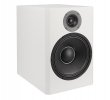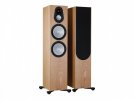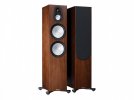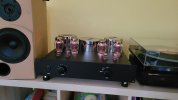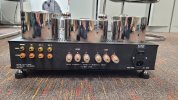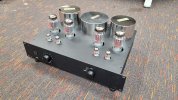The form factor allows for a more classic driver complement with a large bass driver and wide front baffles .
these designes phased out due to fashion and home decor rather than pure acoustical concerns . Even compromise performance ?
many brands have worked around it and have good slim towers to , wide baffle speakers have a different set of compromises some listeners like that .
in their marketing white papers KEF a modern speaker manufacturers make it sound like a slim front is desirable in all cases , but they are a bit selective in how they present data ( it’s my favorite brand I own mostly kef speakers now , so I don’t pick on them in particular).
but the number one factor in commercial speaker design is that someone must desire to buy the speaker or they go broke.
or they go broke.
so everyone adapts to current fashion .
but 90dB sensitivity and high impedance excludes almost all modern speakers.
and it’s some of the most fudged data in speakers ( low frequency extension and nominal impedance are the others ) so 90dBw for real ?
you can almost always remove 3dB due the speakers are in practice 4 ohm even if they say 8 ohm . So the 2,83 volts who give 1w in 8 ohm are 2w ? If they are Klipsh speakers remove 10dB . Look at third party measurement for this spec ( or buy a kW of class D amp and don’t care )
)
as power is cheap nowadays high sensitivity is not a priority ,but I bet ASR members will find exceptions to post in this tread..
these designes phased out due to fashion and home decor rather than pure acoustical concerns . Even compromise performance ?
many brands have worked around it and have good slim towers to , wide baffle speakers have a different set of compromises some listeners like that .
in their marketing white papers KEF a modern speaker manufacturers make it sound like a slim front is desirable in all cases , but they are a bit selective in how they present data ( it’s my favorite brand I own mostly kef speakers now , so I don’t pick on them in particular).
but the number one factor in commercial speaker design is that someone must desire to buy the speaker
so everyone adapts to current fashion .
but 90dB sensitivity and high impedance excludes almost all modern speakers.
and it’s some of the most fudged data in speakers ( low frequency extension and nominal impedance are the others ) so 90dBw for real ?
you can almost always remove 3dB due the speakers are in practice 4 ohm even if they say 8 ohm . So the 2,83 volts who give 1w in 8 ohm are 2w ? If they are Klipsh speakers remove 10dB . Look at third party measurement for this spec ( or buy a kW of class D amp and don’t care
as power is cheap nowadays high sensitivity is not a priority ,but I bet ASR members will find exceptions to post in this tread..

